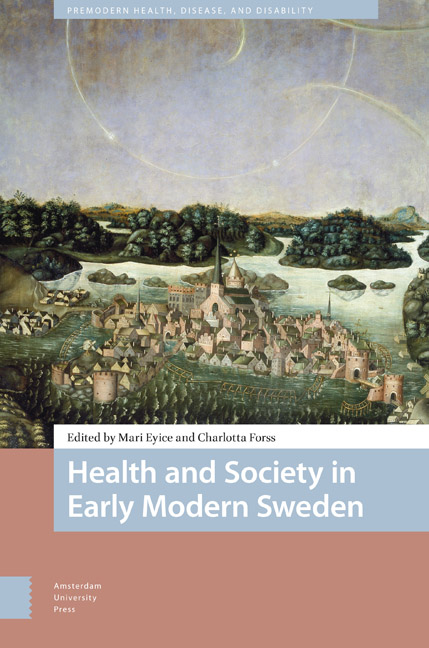Book contents
- Frontmatter
- Contents
- List of Tables and Figures
- Acknowledgements
- 1 Meanings of Health in Early Modern Sweden
- 2 Illness as Incapacity to Work in Early Modern Sweden
- 3 The Body in the Bathhouse: Health and Bathing in Early Modern Sweden
- 4 ‘Somewhat Heated, Quick and Lively’ : Humoral Explanations of the Learning Difficulties of Charles XI of Sweden (1655–1697)
- 5 Health in Body and Soul in a Female Birgittine Convent 1516–1522
- 6 Curing Madness and Mental Disturbances : Religious Healing Activities in Early Modern Swedish Local Communities
- 7 Not Quacks but Close : Reappraising the Role of Physicians on the Eighteenth-Century Medical Market
- 8 Gender, Health, and Hair in Sweden, 1740–1840
- 9 Gender Norms and Early Modern Healthcare : Barber-Surgeons in Sweden c. 1600–1900
- Epilogue : Epistemologies of Body and Soul: Considering the Early Modern and (Late) Modern History of Health
- Index
8 - Gender, Health, and Hair in Sweden, 1740–1840
Published online by Cambridge University Press: 16 April 2024
- Frontmatter
- Contents
- List of Tables and Figures
- Acknowledgements
- 1 Meanings of Health in Early Modern Sweden
- 2 Illness as Incapacity to Work in Early Modern Sweden
- 3 The Body in the Bathhouse: Health and Bathing in Early Modern Sweden
- 4 ‘Somewhat Heated, Quick and Lively’ : Humoral Explanations of the Learning Difficulties of Charles XI of Sweden (1655–1697)
- 5 Health in Body and Soul in a Female Birgittine Convent 1516–1522
- 6 Curing Madness and Mental Disturbances : Religious Healing Activities in Early Modern Swedish Local Communities
- 7 Not Quacks but Close : Reappraising the Role of Physicians on the Eighteenth-Century Medical Market
- 8 Gender, Health, and Hair in Sweden, 1740–1840
- 9 Gender Norms and Early Modern Healthcare : Barber-Surgeons in Sweden c. 1600–1900
- Epilogue : Epistemologies of Body and Soul: Considering the Early Modern and (Late) Modern History of Health
- Index
Summary
Abstract
This chapter examines changing views on haircare, health, and gender in Sweden from 1740 to 1840. By investigating haircare in recipes, journals, and advertising, the chapter outlines the connections drawn between outer appearances and inner wellness in the early modern period. It also shows how these connections were gendered. In the eighteenth century, hair was commercialised through the use of wigs and a growing market for haircare recipes. These recipes were a mixture of health cures and cosmetic concoctions. By the early nineteenth century, haircare manuals were becoming more gendered than before. Books about haircare for men were focused on hair as a signifier of health, while haircare and advertising for women was concerned with hair as a signifier of beauty.
Keywords: health, beauty, haircare, medicine, gender, bodies
Introduction
This chapter examines the connections between haircare, medicine, gender, and health in Sweden between the years 1740 and 1840. The periodisation covers a drastic change in hair fashions, particularly for elite men who went from wearing powdered hairstyles and wigs in the eighteenth century to more moderate styles in the early nineteenth century. It also covers the growth of a type of literature about haircare and cosmetics, a genre that was separate from but which still drew on household recipes and medical texts. Advice literature, newspapers, and journals of this period created a discursive framework in which beauty tips were combined with popular conceptions of medical science. In these diverse texts, hair was a part of the body and thus a signifier of a body's health, vitality, and morality. At the same time, hair was something separate, easy to alter, remove, and transform into a commodity. Moreover, it was paradoxically both gendered and not gendered. By comparing different genres of writing, this chapter shows that there was a tension between the various ways hair was conceptualised during this period. One continuous strand in the discussions of hair and haircare throughout the period is the connection drawn between healthy hair and health of the body.
The chapter includes an overview of the way haircare appeared in economic texts, medical writing, popular journals, and haircare manuals. The study additionally examines the growth of a new genre of advice literature in Sweden, and how it carried with it traditions from older genres.
- Type
- Chapter
- Information
- Health and Society in Early Modern Sweden , pp. 175 - 198Publisher: Amsterdam University PressPrint publication year: 2024

